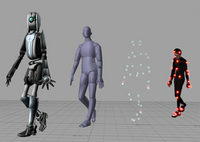Volume rendering

Volume rendering is a way to see inside 3D objects, like a big toy or a colorful ball. Imagine you're holding a ball made of different colored candy pieces. If you look at the ball from the outside, you can only see the colors on the surface. But if you take a slice of the ball and look at it from the side, you can see all the colors inside.
That's what volume rendering does with 3D objects. It takes a lot of slices, like a loaf of bread, and puts them together to make a picture that looks like it's made of the inside of the object. It's like you cut the ball into a lot of thin slices and rearranged them to show all the colors inside.
But instead of candy, it's usually used on medical images or scientific data. Doctors can use volume rendering to see inside your body without having to cut you open. They can look at pictures of your organs and muscles and see if anything is wrong. Scientists use it to study things like the earth's layers or the way molecules interact.
Volume rendering can be really helpful because it lets you see things that you couldn't see just by looking at the surface. So it's a bit like having x-ray vision, but without all the superhero powers.
That's what volume rendering does with 3D objects. It takes a lot of slices, like a loaf of bread, and puts them together to make a picture that looks like it's made of the inside of the object. It's like you cut the ball into a lot of thin slices and rearranged them to show all the colors inside.
But instead of candy, it's usually used on medical images or scientific data. Doctors can use volume rendering to see inside your body without having to cut you open. They can look at pictures of your organs and muscles and see if anything is wrong. Scientists use it to study things like the earth's layers or the way molecules interact.
Volume rendering can be really helpful because it lets you see things that you couldn't see just by looking at the surface. So it's a bit like having x-ray vision, but without all the superhero powers.
Related topics others have asked about:
